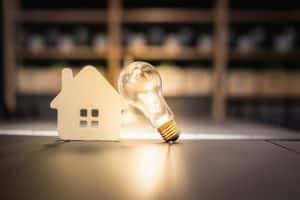Home > Energy Plans > How To Monitor Electricity Usage
How To Monitor Electricity Usage
Are you struggling with large power bills and wondering how to monitor your electricity usage? Find out how to keep tabs on your power use here with Savvy.
Author
Savvy Editorial TeamFact checked

Monitoring your electricity usage is a vital part of managing your energy consumption effectively. By keeping an eye on how much electricity you use, you may be able to find opportunities to save energy, cut down on waste, and bring down those sky-high electricity bills. Savvy is here to help you with practical tips and techniques about how to monitor your electricity usage. Take charge of your energy consumption and make smart decisions about how you use electricity here with Savvy!
How can I monitor and check my home's electricity usage?
There’s an old saying that knowledge is power. This is definitely the case with your household energy consumption. Monitoring your electricity usage is the first step towards making an informed decision about reducing energy consumption and saving on your energy plan. It allows you to identify areas where you can make changes, and so improve on the energy efficiency in your home.
To monitor your electricity use and track electricity consumption, you have several options available. These include:
Use a power meter to monitor the energy use of specific appliances
A simple energy meter can be purchased online or from hardware stores from as little as $20. Many libraries around Australia also have them for loan, so you can work out the power consumption of individual appliances. Knowing which of your appliances are using the most power can give you the knowledge you need to cut down on your electricity consumption and save money. You may be shocked how much energy some appliances are drawing even when they are in standby mode!
To use a simple hand-held power meter, all you have to do is plug it into your electricity socket, and then plus the appliance into it. It'll present useful data about that appliance’s energy use on an LCD screen. If you provide your electricity tariff rate, the power meter may be able to tell you how many cents that appliance is costing you to run per minute or per hour.
Connect an energy monitoring system to your meter
Smart energy monitors are devices that monitor how much energy your home uses. They can help you improve your energy efficiency. By connecting a monitor to your energy meter, it will provide information about your electricity usage in real time, and can give you an insight as to how to reduce your home’s energy consumption. The system will usually have to be installed by a licensed electrician.
Energy monitors provide real-time and historical electricity usage information, helping you identify when and how you're using power. They will often be connected to an in-home display, so you can see the information you want by looking at a small display mounted on your wall.
These monitors can detect appliances that are consuming excessive energy, and will calculate the cost of your electricity usage in real time. They can also be programmed to warn you during peak usage times, or if you exceed a pre-set usage level. They are relatively simple to understand, and can be more affordable than you might expect. There are different types of energy monitors available, including wireless electricity monitors and online energy monitors.
Install an energy use app connected to a monitoring meter
These apps are relatively new on the Australian market. They work by wirelessly connecting to an energy monitor, which is connected to your smart meter. They relay usage information to your phone so you can see in real time how much power you’re using.
Apps like PowerPal and Wattcost provide real-time data on your energy habits and can help you manage your electricity consumption. They are available for both Android and iOS-based phones. Currently in 2023 the Victorian State Government is providing Powerpal smart energy monitors for free to eligible households in Victoria under the Victorian Energy Upgrades scheme.
Conduct an energy audit
An energy audit can provide valuable insights into your energy usage. During an audit, you analyse all the electrical appliances you use in your household, how you use them, and how much they contribute to your overall electricity consumption.
Energy audits help you identify areas where you can improve energy efficiency and reduce wastage. While you can conduct a basic energy audit yourself, hiring a professional can provide a more accurate and comprehensive assessment to help you manage your power usage.
How do I know how much different appliances cost to run?
To determine how much different appliances cost to run, follow these steps:
- Identify the power rating of the appliance: Look for the wattage rating or power consumption information on the appliance itself, or in the user manual which came with the appliance. Usage is usually indicated in watts (W) or kilowatts (kW).
- Convert the power rating to kilowatts: If the power rating is given in watts, divide it by 1000 to convert it to kilowatts. For example, if an appliance has a power rating of 1200 watts, it is equivalent to 1.2 kilowatts.
- Determine the time the appliance is used: Estimate the number of minutes or hours per day that you typically use the appliance.
- Determine the tariff rate for electricity: Check your electricity bill or contact your energy provider to find out the tariff rate you are being charged. Tariff rates may vary depending on the time of day, so it's important to consider the applicable rate for the specific period when the appliance is used.
- Calculate the energy consumption: Multiply the power rating of the appliance (in kilowatts) by the number of hours it is used each day. Then, multiply this result by the tariff rate per kilowatt-hour (kWh) to calculate the cost of running the appliance.
For example, let's say you have a 1.2 kW appliance that is used for 4 hours per day, and your tariff rate is $0.25 per kWh. The calculation would be:
1.2 kW x 4 hours = 4.8 kWh per day.
Then, 4.8 kWh x $0.25 = $1.20 per day.
By following these steps, you can estimate the energy consumption and cost of running different appliances based on the tariff rate you are being charged. This information can help you make informed decisions about managing your energy usage and potentially reduce your electricity bill shock.
Which appliances in an average house use the most electricity?
Here’s some energy use statistics for Australia about the appliances in a home that on average consume the most power:
- Air conditioners: High-capacity air conditioners can consume an average of 2,000 to 5,000 watts (2-5 kilowatts) during operation, depending on their cooling or heating capacity and efficiency rating.
- Electric water heaters: Electric water heaters typically use around 3,000 to 5,000 watts (3-5 kilowatts) when heating water for domestic use.
- Electric ovens and microwaves: Electric ovens have an average power use ranging from 1,200 to 2,400 watts (1.2-2.4 kilowatts) during cooking, depending on the size and features of the oven. Microwave ovens will use between 500 and 800 watts (0.5-0.8 kilowatts) for a compact microwave, or 800 to 1,800 watts (0.8-1.8 kilowatts) for a family-sized model.
- Electric clothes dryers: Electric clothes dryers commonly consume approximately 2,500 to 4,500 watts (2.5-4.5 kilowatts) per hour when in operation.
- Swimming pool pumps: Swimming pool pumps will have varying power usage depending on the size and efficiency of the pump. On average, they consume around 500 to 2,000 watts (0.5-2 kilowatts) per hour of use, so if they are used continuously, they can be very expensive to run 24/7.
- Electric range cooktops: Electric cooktops typically have burners ranging from 1,000 to 2,500 watts (1-2.5 kilowatts) each, depending on the size and heat output of the burners.
- Hot tubs/spas: Hot tubs and spas with heating and jet systems can have an average power usage ranging from 2,000 to 6,000 watts (2-6 kilowatts) per hour, depending on the size and features of the unit.
- Electric heating: Electric heating systems like electric furnaces or electric space heaters can consume an average of 1,000 to 2,500 watts (1-2.5 kilowatts) per hour, depending on the size and heating capacity.
- Home theater systems: Home theater systems, including televisions, audio systems, and gaming consoles, can have varying power usage. Televisions generally consume around 100 to 500 watts (0.1-0.5 kilowatts) depending on the size and technology.
- Home office equipment: Home office equipment like desktop computers, printers, and monitors can have varying power usage. Desktop computers typically consume around 200 to 500 watts (0.2-0.5 kilowatts), monitors consume approximately 20 to 70 watts (0.02-0.07 kilowatts), and printers consume around 50 to 100 watts (0.05-0.1 kilowatts).
These are average estimates, and actual power usage will vary based on factors such as the energy efficiency rating of the particular appliance. It's important to consult the manufacturer's specifications or check energy labels for accurate power consumption information for specific appliances.
What is ‘phantom’ or ‘vampire’ power use, and how do I stop it?
‘Phantom' or ‘vampire' power use refers to the energy consumed by electronic devices and appliances even when they are turned off or in standby mode. These devices continue to draw power, resulting in unnecessary energy consumption and increased electricity bills. They are a ‘hidden’ form of energy use that ‘steals’ power from the electricity grid, even when you think the device is turned off or not in use.
How do I stop phantom power use?
Here are some steps you can take to stop or minimise phantom power use and reduce your electricity bills:
- Unplug devices: When not in use, unplug electronic devices and appliances from the power outlet. This ensures they are completely disconnected from the power source and eliminates phantom power consumption.
- Use power strips: Connect multiple devices to a power strip and switch it off when not in use. This cuts off power supply to all connected devices at once, preventing standby power usage.
- Choose energy-efficient devices: Opt for energy-efficient appliances and electronics with low standby power consumption. Look for devices with the highest energy star label, as they are far more efficient to run than low-efficiency devices.
- Utilise timers or smart plugs: Set timers or use smart plugs to automatically turn off devices during specific periods when they are not needed, such as overnight or when you are away from home.
- Enable power-saving modes: Many devices have power-saving features or eco-mode settings. Enable these options to reduce power consumption during standby or idle periods.
- Unplug chargers: Disconnect chargers (e.g., for smartphones, laptops) from the power outlet when the devices are fully charged or not in use.
- Check energy monitoring devices: Use energy monitoring devices or smart meters to identify devices with high standby power usage. This helps you pinpoint and address the most significant phantom power culprits.
- Educate the kids! Tell your children about phantom power, and the importance of unplugging and completely turning off devices such as games consoles and TVs when they are not in use.
By following these steps, you can minimise phantom power consumption, reduce wasted energy, and potentially lower your electricity bills.
Helpful energy guides
Compare energy plans
Disclaimer:
Savvy is partnered with Econnex Comparison (CIMET Sales Pty Ltd, ABN 72 620 395 726) to provide readers with a variety of energy plans to compare. We do not compare all retailers in the market, or all plans offered by all retailers. Savvy earns a commission from Econnex each time a customer buys an energy plan via our website. We don’t arrange for products to be purchased directly, as all purchases are conducted via Econnex.
Any advice presented above is general in nature and doesn’t consider your personal or business objectives, needs or finances. It’s always important to consider whether advice is suitable for you before purchasing an energy plan. For further information on the variety of energy plans compared by Econnex, or how their business works, you can visit their website.










